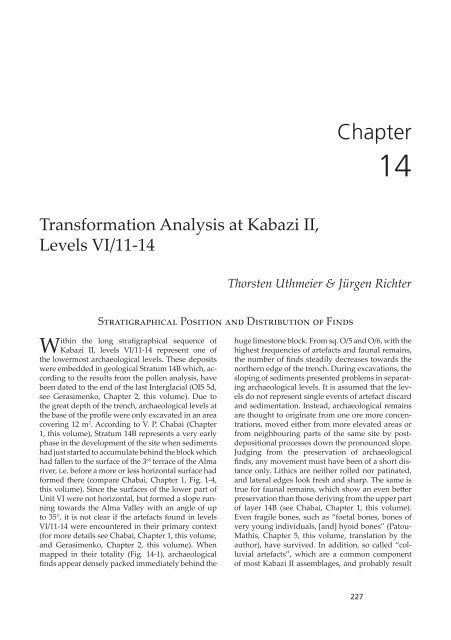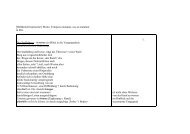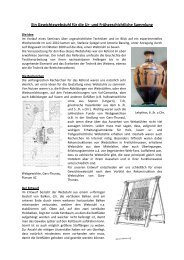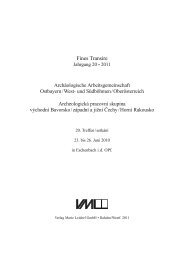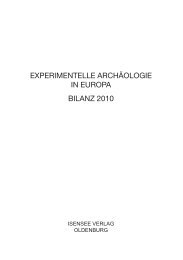Thorsten Uthmeier & Jürgen Richter
Thorsten Uthmeier & Jürgen Richter
Thorsten Uthmeier & Jürgen Richter
Create successful ePaper yourself
Turn your PDF publications into a flip-book with our unique Google optimized e-Paper software.
Transformation Analysis at Kabazi II,<br />
Levels VI/11-14<br />
Within the long stratigraphical sequence of<br />
Kabazi II, levels VI/11-14 represent one of<br />
the lowermost archaeological levels. These deposits<br />
were embedded in geological Stratum 14B which, according<br />
to the results from the pollen analysis, have<br />
been dated to the end of the last Interglacial (OIS 5d,<br />
see Gerasimenko, Chapter 2, this volume). Due to<br />
the great depth of the trench, archaeological levels at<br />
the base of the profile were only excavated in an area<br />
covering 12 m2 . According to V. P. Chabai (Chapter<br />
1, this volume), Stratum 14B represents a very early<br />
phase in the development of the site when sediments<br />
had just started to accumulate behind the block which<br />
had fallen to the surface of the 3rd terrace of the Alma<br />
river, i.e. before a more or less horizontal surface had<br />
formed there (compare Chabai, Chapter 1, Fig. 1-4,<br />
this volume). Since the surfaces of the lower part of<br />
Unit VI were not horizontal, but formed a slope running<br />
towards the Alma Valley with an angle of up<br />
to 35°, it is not clear if the artefacts found in levels<br />
VI/11-14 were encountered in their primary context<br />
(for more details see Chabai, Chapter 1, this volume,<br />
and Gerasimenko, Chapter 2, this volume). When<br />
mapped in their totality (Fig. 14-1), archaeological<br />
finds appear densely packed immediately behind the<br />
Chapter<br />
227<br />
14<br />
<strong>Thorsten</strong> <strong>Uthmeier</strong> & <strong>Jürgen</strong> <strong>Richter</strong><br />
S�������������� P������� ��� D����������� �� F����<br />
huge limestone block. From sq. O/5 and O/6, with the<br />
highest frequencies of artefacts and faunal remains,<br />
the number of finds steadily decreases towards the<br />
northern edge of the trench. During excavations, the<br />
sloping of sediments presented problems in separating<br />
archaeological levels. It is assumed that the levels<br />
do not represent single events of artefact discard<br />
and sedimentation. Instead, archaeological remains<br />
are thought to originate from one ore more concentrations,<br />
moved either from more elevated areas or<br />
from neighbouring parts of the same site by postdepositional<br />
processes down the pronounced slope.<br />
Judging from the preservation of archaeological<br />
finds, any movement must have been of a short distance<br />
only. Lithics are neither rolled nor patinated,<br />
and lateral edges look fresh and sharp. The same is<br />
true for faunal remains, which show an even be�er<br />
preservation than those deriving from the upper part<br />
of layer 14B (see Chabai, Chapter 1, this volume).<br />
Even fragile bones, such as “foetal bones, bones of<br />
very young individuals, [and] hyoid bones” (Patou-<br />
Mathis, Chapter 5, this volume, translation by the<br />
author), have survived. In addition, so called “colluvial<br />
artefacts”, which are a common component<br />
of most Kabazi II assemblages, and probably result


